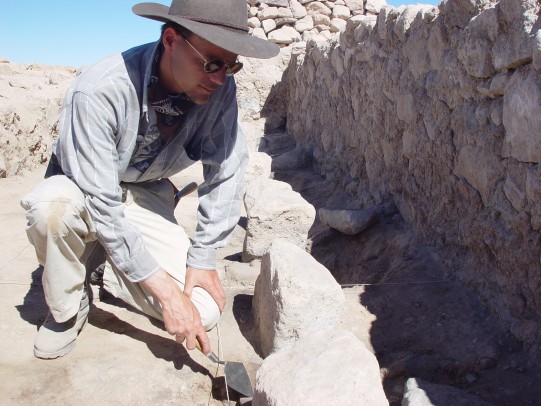Unearthing bygone breweries in Peru

Ryan Williams, adjunct professor of anthropology and head of the Field Museum’s anthropology section, studies ancient civilizations in Peru.
Peru’s Wari and Tiwanaku peoples coexisted peacefully for 400 years, and one reason was that they drank beer together.
“It was a very important part of their détente,” says Ryan Williams, adjunct professor of anthropology and head of the Field Museum’s anthropology section.
Twelve years ago Williams and museum colleagues discovered the remains of a brewery in the mountaintop city of Cerro Baúl, home to elite members of the 600-1000 A.D. Wari empire.
On March 3, the Field will introduce Wari, “a modern beer inspired by a Wari recipe,” Williams said.
The museum commissioned it from Off Color Brewing, a craft brewery in Logan Square. Peruvian pepper berries and purple corn are the chief ingredients of the purple ale, known as “chicha de molle.”
Wari and Tiwanaku drinking vessels dating from 600 A.D. may be found in the Field’s collection.
“The Wari hosted great parties and feasts, and Tiwanaku leaders were visitors,” Williams said.
“Eating and drinking together on important occasions — what social scientists call ‘commensal politics’ — allowed the Wari and Tiwanaku to form collaborative relationships despite their vast differences.”
Preceding the Incas by four centuries, the two empires were the first to inhabit the Andes Mountains.
The Wari expanded along the spine of the Andes, next to the Pacific Ocean.
The Tiwanaku started on a high plateau of Bolivia — on the shores of Lake Titicaca, the highest navigable lake in the world — and moved west, seeking fish from the sea and corn they couldn’t raise at home, and encountering the Wari.
“There is no evidence of bellicose behavior,” Williams said. “Sometimes one would shun the other, but for 400 years in the same valley they never came to blows.”
He’s been doing field work in the region for 25 years, spending two to three months a year.
On his last visit, he explored what he expected to be a Wari temple but found incense burners and obsidian glass tools used by the Tiwanaku.
“There was evidence of ritual activities, conducted by Tiwanaku priests in a Wari city,” he said. “It’s the Jerusalem of the Andes, with the Wari and Tiwanaku coexisting.”
In May he’ll head back to Peru with UIC undergrads and grad students and his wife, Donna Nash, an assistant professor of archeology at the University of North Carolina at Greensboro.
“We’ve found evidence that people today are still making pilgrimages, sacrificing llamas and alpacas,” Williams said.
The local government proposes to rebuild part of one site.
“They’re talking about making it the Machu Picchu of the south, based on our research,” he said, referring to the Inca-built tourist attraction.
Mummies from Peru and Egypt, all from the Field’s collection, are touring the country in an exhibit called “Mummies: Images of the Afterlife.”
It recently closed in Los Angeles and will be in Minneapolis until October. The exhibit moves on to Denver and New York City, finally reaching Chicago in February 2018.
Mummification began in Peru about 5000 B.C.; in Egypt, about 3500 B.C.
“The Egyptians embalmed their mummies, removing the brain and organs,” Williams said. “Most of the Peruvian culture placed them in a fetal position. They were wrapped in textiles, not embalmed.”
Williams grew up in Door County, Wisconsin. He earned a bachelor’s degree at Northwestern University and a master’s and Ph.D. at the University of Florida.
“I met the love of my life the first year of grad school, and she was going to Florida,” he said. “And one of the great minds in South American archaeology, Mike Moseley, is a professor at the University of Florida.”
Williams was a visiting assistant professor at the U of Florida from 1997 to 2000, and joined UIC in 2001.
The Williamses have homes in Homewood and Greensboro. “We’re one of those split academic couples,” he said. “We see each other at least twice a month.”
All three of their children are in college: Eric, 25, at the University of North Carolina at Chapel Hill; Arica, 21, at Illinois Wesleyan University, and Iain, 19, at the University of North Carolina at Wilmington.
“I didn’t know what I wanted to do in college,” Williams said. “When I found anthropology, I was enthralled.
“It gives you an incredible insight into the lives of people who thrived on this planet. Ninety-nine percent of history was never written down, and many languages are not spoken on Earth today.
“We learn from trash, abandoned homes and temples, figurines that may have been the toys of children — the remnants of their civilizations.”
Categories
